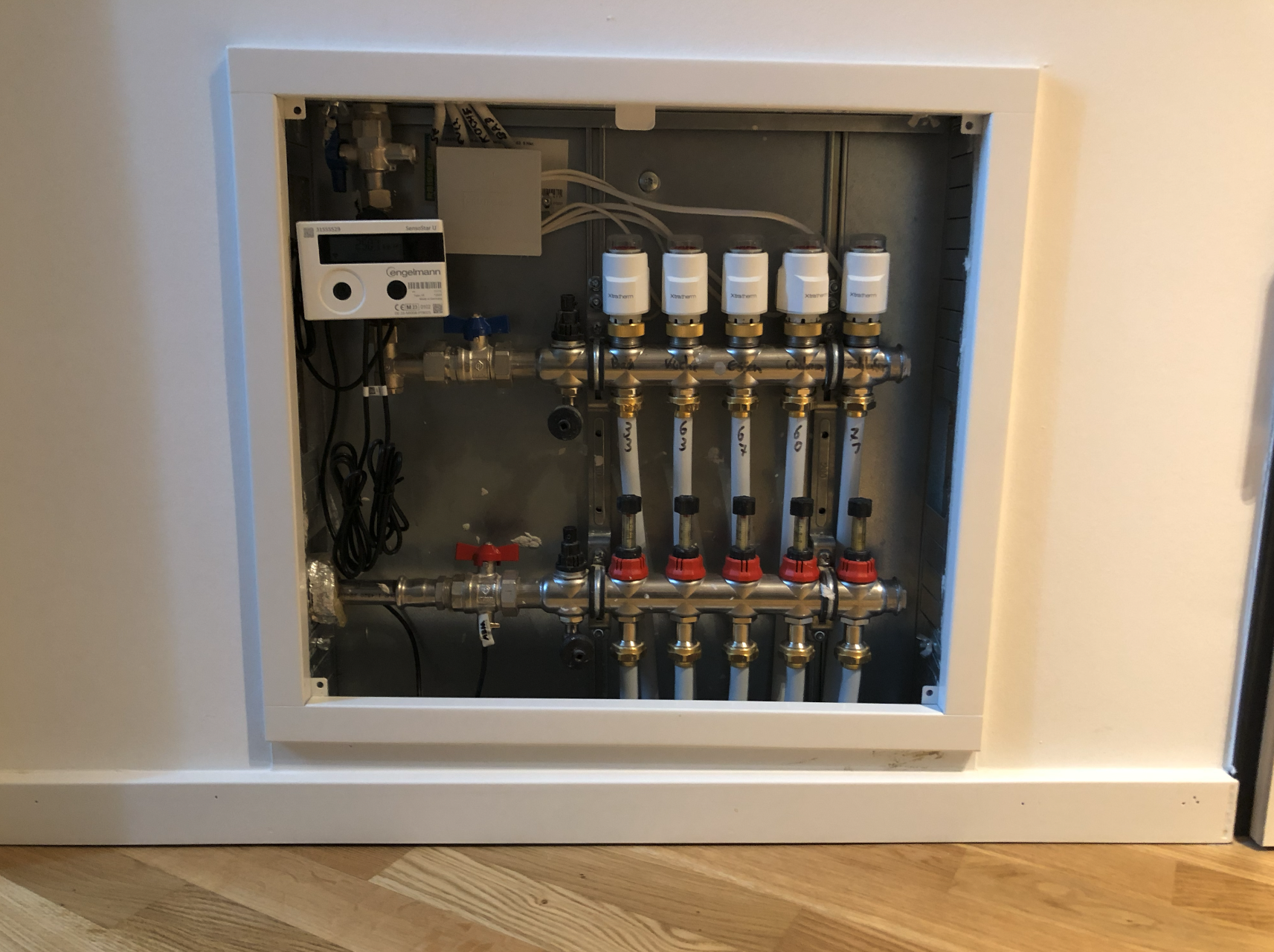Virtual assistant
Installer
Getting Started Guide
Solutions and documentation structure
Equipment ordering and commissioning
General terms and conditions of sale and warranty
Wiring diagrams
Gateway and communication
Community - Electricity Metering - RCP
Heating - Heating metering and water
Mobility - EV Charging Stations
EBike - Recharge electric bikes
Washaccess - Collective laundry manager
Self-consumption optimization
Building energy monitoring
Equipment and installation
Charging infrastructure and relays
Metering infrastructure
Communication infrastructure
Climkit Gateway
4G Router
LAN Router
RS485-Ethernet Converter
Switch ethernet DIN POE
WiFi Network
MBus-RS485 Converter
Storage system (battery)
Configuration and commissioning
Commissioning
Getting Started Guide
Add a router to a site
Add a Climkit Gateway to a site
Electricity meter configuration
Charging station configuration
Configuration of heating and water meters (MBus)
Installation of Shelly relay meters
Optimization via EV relays and charging stations
Checking meter connection status
Advanced configuration
Configuration Gateway
RFID reader and relay meter configuration
IP network configuration and routers
RS485-Ethernet TCP/IP Converters
Configure Teltonika RUT241
Display configuration
Modbus Meter Configuration
Metering data processing
Manually read meter
Inepro PRO380 Meters and various
ABB Terra AC Charging Station Configuration
Wallbox configuration
Firewall rules for Climkit Gateway
Schneider EVlink Pro AC Charging Station Configuration
Zaptec Charging Station Configuration
Owner
Administrative setup
Getting started guide - administrative setup
Form - 1. Contact details
Form - 2. Solutions
Form - 3. Rates
Contract and documents to complete
Owner account
Consumer information flyers
Online access, RFID badge and charging stations
FAQ and other information
Resident
Platform
Platform access
Terminology
Site
Parameters
Creation/edit of a note or to-do item
Closing an open issue
Site statuses
Add/Modify building(s)
The steps for setting up a site
Delete/deactivate a site
Add/Edit Equipment(s)
Modify site basic information
Equipment
Add/modify a gateway
Add/modify a router
Add/modify an electricity meter
Bulk meter insertion
Mass assigning meters to a gateway
Add/edit a distribution zone
Add/modify a charging station
Add/modify a thermal or water meter
Add/edit a DSO meter (FTP transfer)
Remote connection to a Climkit gateway
Administration
Stakeholders
Financial conditions
Visualizing Site Management Conditions
Activating/Deactivating a Solution
Configuration of the Operating Method
Visualizing Financial Conditions
Creation/editing/addition of a financial condition
Removal of a financial condition
Accounts
Create a consumer account
Create a contact
View and download account invoices
Send platform access to a contact
Add/modify billing address
Link an existing account to a site
Changing the correspondence method
Rates and billing points
Creating/editing a billing point
Register a move (relocation)
Account assignment to a billing point
Add/edit default charge advance payment for a billing point
View site consumption rates
Consumption Rate Edition
Creation/editing of a consumption tariff
Creation/editing of a Tariff component
View fixed rates and subscriptions
Customize invoice position labels/titles
View Financial conditions billed at billing points
RFID badges
Accounting
Tools
Meter control
Visualization
Expense accounts
Introduction to the Expense Statement Tool
Create/edit an expense accounting period
Modify expense statement settings
Add/edit a overhead expense invoice on an expense statement
Edit collected advance payments of an expense statement
Specifics of heating and hot water production costs
Check and download meter readings for the cost accounting period
Allocate expenses and generate expense statements
Exporting individual consumptions for the billing period
API
Table of Contents
- Categories
- Installer
- Wiring diagrams
- Heating - Heating metering and water
Heating - Heating metering and water
1. Connection Diagram
Individual heating and water metering allows for the fairest possible distribution of heating costs among the occupants of a building.
According to the requirements of the Swiss Federal Ordinance on the Individual Statement of Energy and Water Costs (DIFEE), in force since 2017, the following must be installed:
- one thermal energy meter (heating) per apartment
- one hot water meter per apartment
- one thermal energy meter at the boiler outlet to measure total consumption and deduct the share for common areas
- one thermal energy meter at the water heater inlet to measure the energy required for hot water production
If an equitable distribution of water consumption and treatment costs is desired, one cold water meter is installed for each apartment and for the common areas (laundry room, watering, etc.).
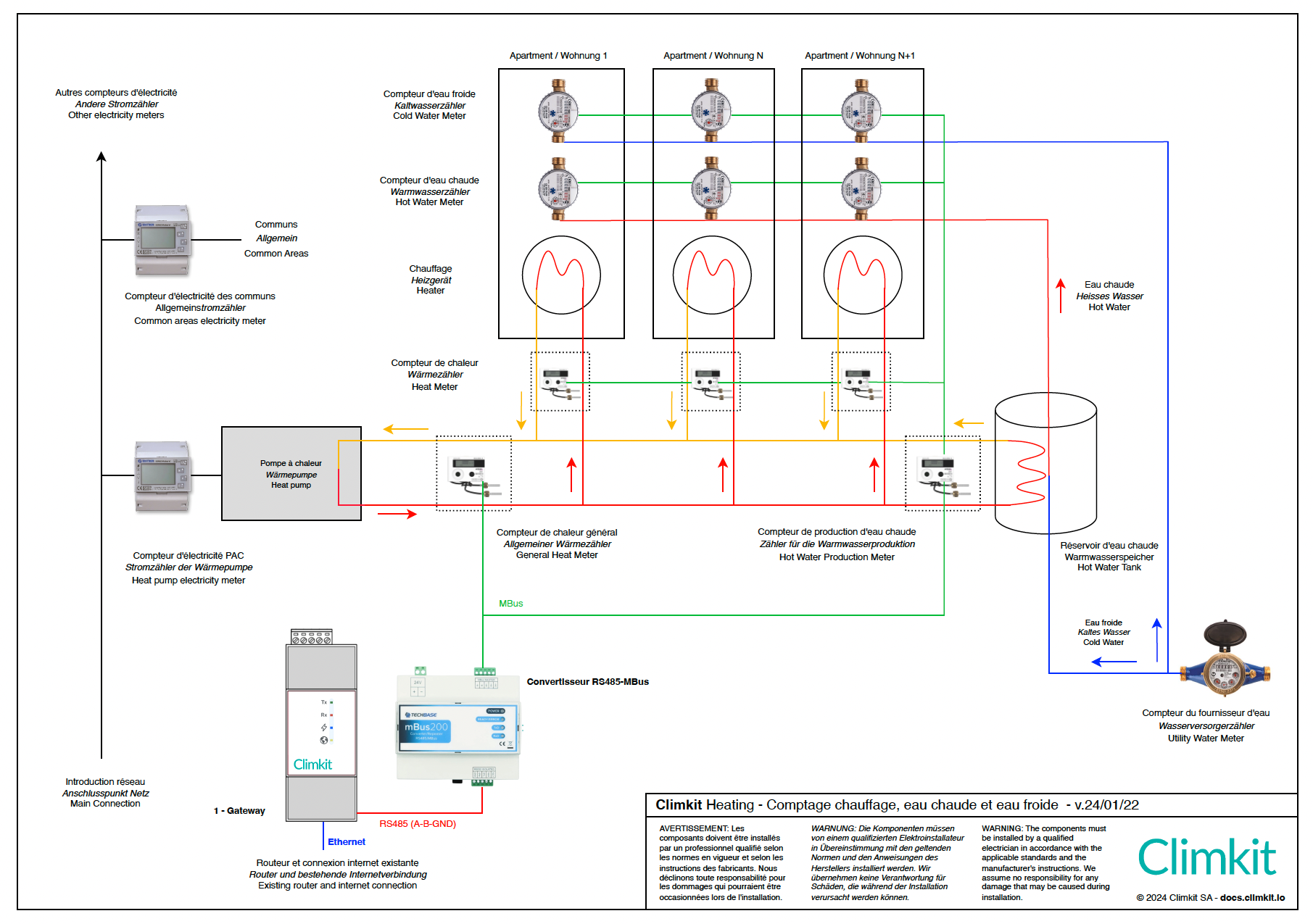
2. Meter Connection
Thermal Meter Connection
The diagrams below also apply to boiler types other than a heat pump (wood, gas, etc.).
Scenario A: One main meter at the boiler outlet, one meter for hot water production, and one meter for each apartment.
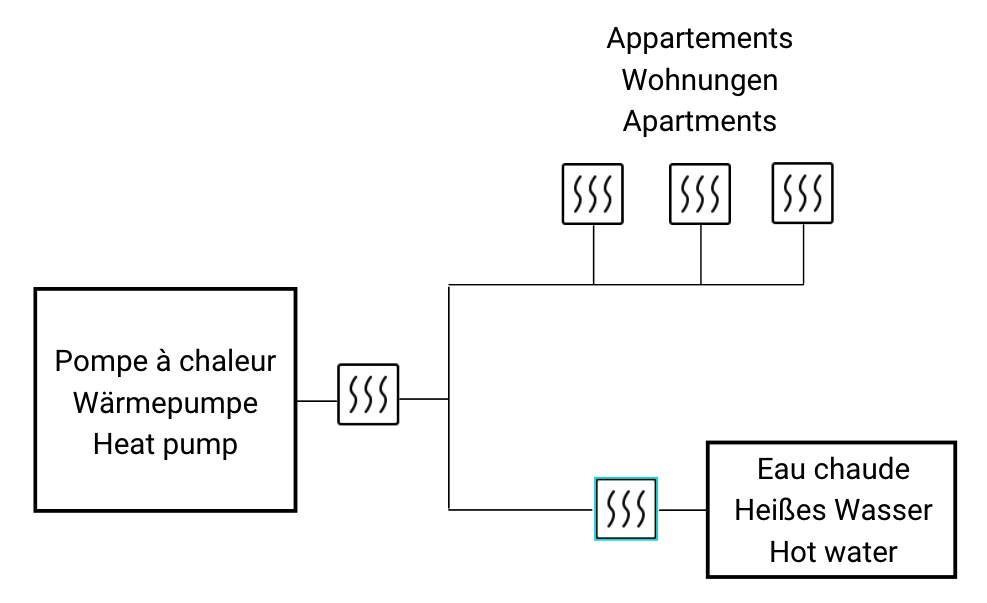
This is the correct diagram as recommended by official guidelines.
Consequence for allocation:
- Heating costs are allocated among each occupant based on consumption measured by individual apartment meters.
- Costs for hot water production are allocated based on each individual's hot water consumption, measured via individual hot water meters.
- Heating costs for common areas are allocated based on apartment surface areas.
Scenario B: Only one meter for each apartment.
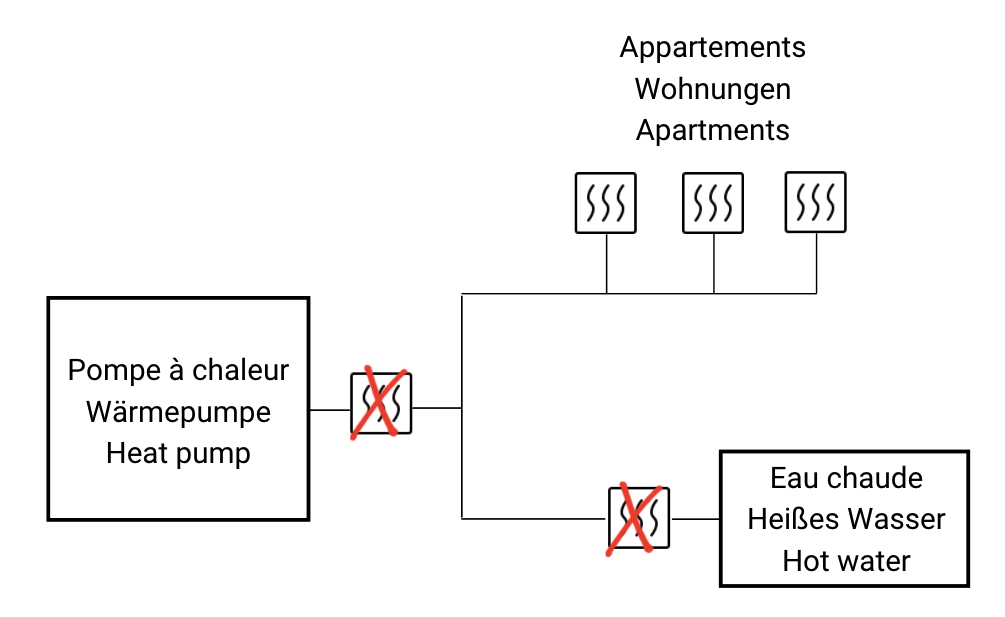
Not everything is measured.
Consequence for allocation:
- Heating costs for common areas are estimated.
- Costs for hot water production are estimated.
If the main meter at the boiler outlet is omitted, it is highly recommended to install at least one meter for hot water production.
Nevertheless, without this meter, the usual estimate is 25% of the total costs dedicated to domestic hot water production.
Scenario C: No meters.
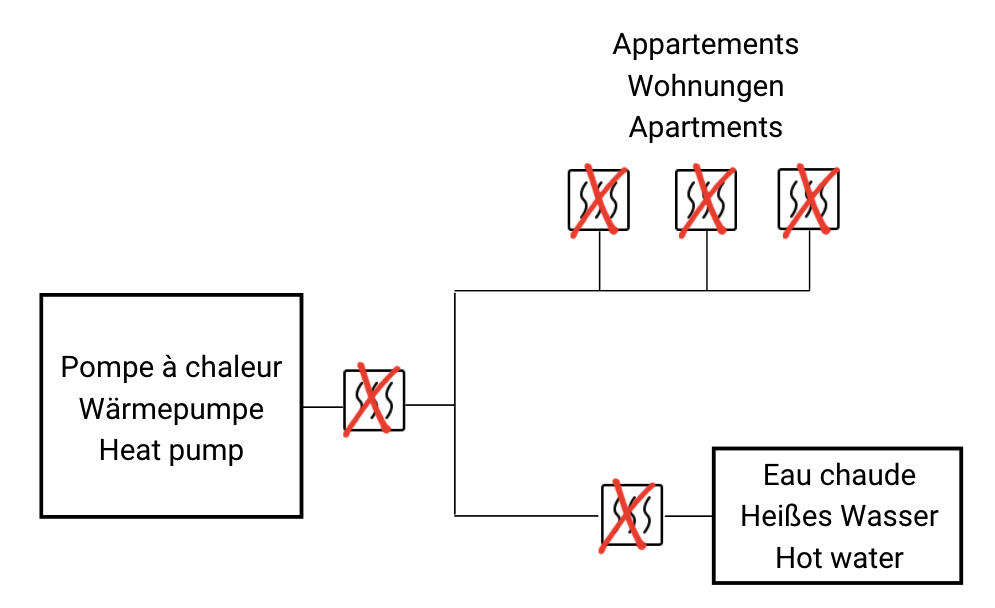
No thermal consumption is measured.
Consequence for allocation: heating costs are allocated based on apartment surface areas.
Electricity Meter Connection
If the heating system is a heat pump (PAC), it is powered by electricity.
Scenario A: One meter for the heat pump and one meter for common areas.
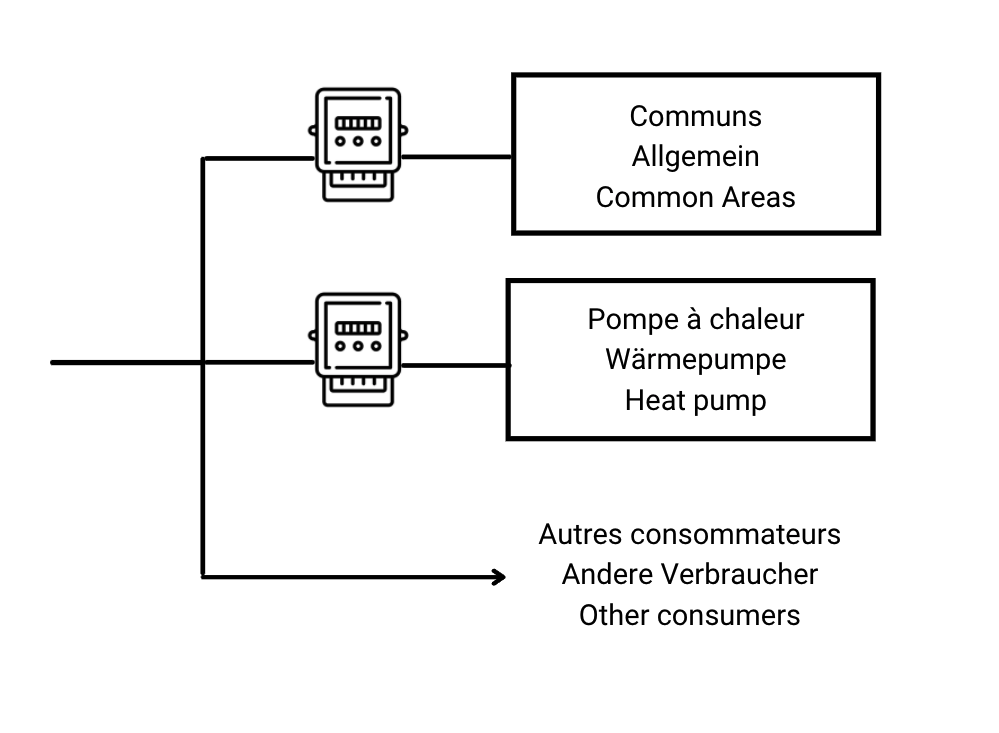
Consequence on allocation: The electricity consumption of the heat pump is separate from the common areas. No estimation is required.
Scenario B: A single meter for the heat pump and common areas.
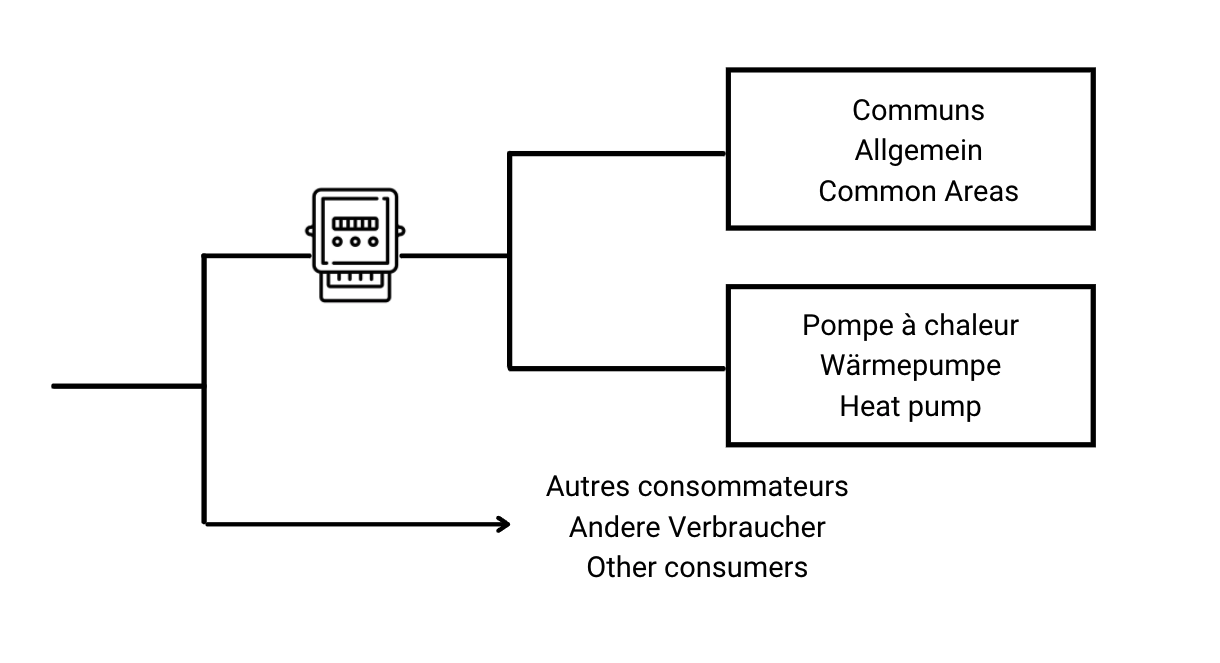
Consequence for allocation: The electricity consumption of the common areas must be estimated.
3. Installation Example
It is strongly recommended to place the underfloor heating manifold and the heating meter in an access hatch located at the entrance of the apartment, rather than at the back of a piece of furniture. This configuration greatly facilitates access to the meter for maintenance.

